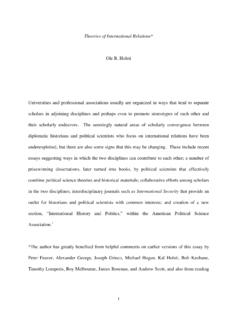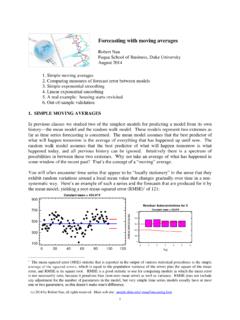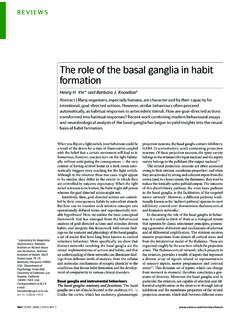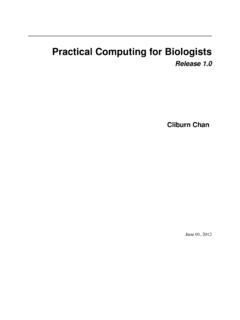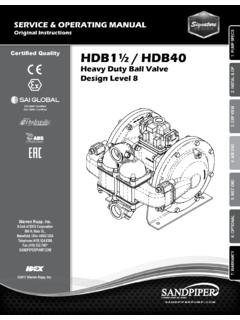Transcription of Review of Strain Energy Methods and Introduction to ...
1 Duke University Department of Civil and Environmental Engineering CEE 421L. Matrix structural analysis Henri P. Gavin Fall, 2012. Review of Strain Energy Methods and Introduction to Stiffness Matrix Methods of structural analysis 1 Strain Energy Strain Energy is stored within an elastic solid when the solid is deformed under load. In the absence of Energy losses, such as from friction, damping or yielding, the Strain Energy is equal to the work done on the solid by external loads. Strain Energy is a type of potential Energy . Consider the work done on an elastic solid by a single point force F . When the elastic solid carries the load, F , it deforms with strains ( and ) and the material is stressed ( . and ). D is a displacement in the same location and in the same direction as a point force, F.
2 D and F are colocated. The work done by the force F on the elastic solid is the area under the force vs. displacement curve. Z. W = F dD (1). This work is stored as Strain Energy U within the elastic solid. 1Z. U= ( xx xx + yy yy + zz zz + xy xy + xz xz + yz yz ) dV. (2). 2 V. This is a very general expression for the Strain Energy , U , and is not very practical for structural elements like bars, beams, trusses, or frames. 2 CEE 421L. Matrix structural analysis Duke University Fall 2012 Gavin Bars For a bar in tension or compression, we have internal axial force, N , only, 1111. 0000. 0000. 1111. 0000. 1111. 0000. 1111. 0000. 1111. 0000. 1111. 0000. 1111. Nx Nx 0000. 1111. 0000. 1111. 0000. 1111. 0000. 1111. x 0000. 1111. 0000. 1111. 0000. 1111. 0000. 1111. 0000. 1111. xx dl xx dl so yy = 0, zz = 0, xy = 0, xz = 0, and yz = 0, and 1Z.
3 U= xx xx dV , 2 V. where xx = N/A and xx = N/EA. Substituting dV = A dx we get 1Z N (x)2. U= dx , (3). 2 L E(x) A(x). and if N , E, and A are constant 1 N2 L. U= . 2 EA. Alternatively, we may express the Strain as a function of the displacements along the bar ux (x), xx = ux (x)/ x, and xx = E ux (x)/ x. Again substituting dV = A dx , !2. 1Z ux (x). U= E(x) A(x) dx , (4). 2 L x and if E, A and ux / x = (u2 u1 )/L are constants, 1 EA. U= (u2 u1 )2. 2 L. CC BY-NC-ND Gavin Strain Energy and Matrix Methods of structural analysis 3. Beams For a beam in bending we have internal bending moments, M , and internal shear forces, V . For slender beams the effects of shear deformation are usually neglected. y v" dl 1111. 0000. 0000. 1111. 0000. 1111. 0000. 1111. 0000. 1111. 0000. 1111. 0000.
4 1111. 0000. 1111. 0000111. 1111000. 000. 111. 000. 111. M zz M zz x 000. 111. 000. 111. 000. 111. 000. 111. 000. 111. 000. 111.. xx dl As in the axially loaded bar, yy = 0, zz = 0, xy = 0, xz = 0, and yz = 0, and 1Z. U= xx xx dV . 2 V. For bending, xx = M y/I and xx = M y/EI. Substituting dV = dA dx, 1 Z Z M (x)2 y 2. U= dA dx , 2 L A E(x) I(x)2. y 2 dA = I, so R. where A. 1Z M (x)2. U= dx . (5). 2 L E(x) I(x). Alternatively, we may express the moment in terms of the curvature of the beam, . 2 uy / x2 , 2 uy (x). M (x) = E(x) I(x) , x2. from which xx = E ( 2 uy / x2 ) y and xx = ( 2 uy / x2 ) y, so that !2. 1Z Z 2 uy (x). U= E(x) y 2 dA dx 2 L A x2. y 2 dA = I, so R. where, again, A. !2. 1Z 2 uy (x). U= E(x) I(x) dx . (6). 2 L x2. CC BY-NC-ND Gavin 4 CEE 421L. Matrix structural analysis Duke University Fall 2012 Gavin Summary External work is done by a set of forces, Fi , on a linear elastic solid, producing a set of displacements, Di , in the same locations and directions.
5 Fi Fj F1. Dj Dn Fn Di D1. Fn Dn Dj 00000. 11111. Di 00000. 11111. 111. 000 11111. 00000 11111. 00000. 000. 111 00000. 11111. 00000. 11111 00000. 11111. 00000. 11111. 000. 111. 000. 111. 000. 111 Fi Fj 000. 111. 000. 111. 000. 111. F1. 000. 111. Fi Fj Fn D D1. 1 Di Dj Dn 11111. 00000. F1 00000. 11111. 00000. 11111. 11111. 00000. 11111. 00000 00000. 11111 11111. 00000. 00000. 11111 00000. 11111 00000. 11111. 00000. 11111 00000. 11111 00000. 11111. The work done by these forces is 1 1 1. W = F1 D1 + F2 D2 + F3 D3 + . 2 2 2. The external forces are resisted by internal moments, M , and axial forces, N . The total Strain Energy stored within the solid is 1 Z M2 1 X Nj2 Lj U= dx + (7). 2 LEI 2 j Ej Aj where the first term is the integral over all lengths of all the beams and the second term is the sum over all the bars.
6 If torsion and shear are included, then two additional terms are 1 Z T2 1Z V2. dx and dx . 2 LGJ 2 L G A/ . Alternatively, we can think of external forces producing curvatures ( 2 uy / x2 ) by bend- ing, and axial stretches ( ux / x). In this case !2. 1Z 2 uy 1 X Ej Aj U= EI dx + (u2j u1j )2 (8). 2 L x2 2 j Lj If torsion and shear are included, then two additional terms are !2 !2. 1Z ux 1Z uy GJ dx , and G A/ dx , 2 L x 2 L x where ux is the torsional rotation about the x-axis, ux / x is the torsional shear Strain , x , (on the face perpendicular to the x-axis and in the -direction) and uy / x is the shear Strain , xy , (on the face perpendicular to the x-axis and in the y-direction). Analyses using expressions of the form of equations (3), (5), or (7) are called force method or flexibility method analyses.
7 Analyses using expressions of the form of equations (4), (6), or (8) are called displace- ment method or stiffness method analyses. CC BY-NC-ND Gavin Strain Energy and Matrix Methods of structural analysis 5. 2 Castigliano's Theorems Castigliano's Theorem - Part I. Z. U= F dD .. Strain Energy F. 1111111. 0000000. 0000000. 1111111. j 0000000. 1111111. 0000000. 1111111. 0000000. 1111111. 0000000. 1111111. 0000000. 1111111. 0000000. 1111111 D. 0000000. 1111111. 0000000. 1111111. j U(D) 0000000. 1111111. U. 0000000. 1111111. 0000000. 1111111. 0000000. 1111111. 0 Dj D+ Dj j U U. Fi = =. Di Di A force, Fi , on an elastic solid is equal to the derivative of the Strain Energy with respect to the displacement, Di , in the direction and location of the force, Fi . Castigliano's Theorem - Part II.
8 Z. U = D dF .. complementary Strain Energy Fj j Fj F+ 1111111111111111111. 0000000000000000000. 0000000000000000000. 1111111111111111111. U*. 0000000000000000000. 1111111111111111111. Fj U*(F). 0 Dj U U . Di = =. Fi Fi A displacement, Di , on an elastic solid is equal to the derivative of the complementary Strain Energy with respect to the force, Fi , in the direction and location of the displacement, Di . If the solid is linear elastic, then U = U . CC BY-NC-ND Gavin 6 CEE 421L. Matrix structural analysis Duke University Fall 2012 Gavin 3 Superposition Superposition is an extremely powerful idea that helps us solve problems that are stati- cally indeterminate. To use the principle of superposition, the system must behave in a linear elastic fashion. The principle of superposition states: Any response of a system to multiple inputs can be represented as the sum of the re- sponses to the inputs taken individually.
9 By response we can mean a Strain , a stress, a deflection, an internal force, a rotation, an internal moment, etc. By input we can mean an externally applied load, a temperature change, a support settlement, etc. 4 Detailed Example of Castigliano's Theorem and Superposition An example of a statically indeterminate system with external loads w(x) and three redundant reaction forces, RB , RC , and RD , is shown below. 000. 111. 000. 111. D. EA. y 1111111111111111111111111111111111111111 11111111111111111111. 0000000000000000000000000000000000000000 00000000000000000000. 0000000000000000000000000000000000000000 00000000000000000000. 1111111111111111111111111111111111111111 11111111111111111111. w(x) H. 0000000000000000000000000000000000000000 00000000000000000000. 1111111111111111111111111111111111111111 11111111111111111111.
10 0000000000000000000000000000000000000000 00000000000000000000. 1111111111111111111111111111111111111111 11111111111111111111. 000. 111. 000. 1110000000000000000000000000000000000000 00000000000000000000000. 1111111111111111111111111111111111111111 11111111111111111111. 0001111111111111111111111111111111111111 11111111111111111111111. 1110000000000000000000000000000000000000 00000000000000000000000. 000. 111. 000. 111 x 000. 111. 000 EI. 111 000. 111 000. 111. 000. 111 000. 111. A B C. L. In general, the displacements at the locations of the unknown reaction forces are known, and, in this example these displacements will be taken as zero: DB = 0, DC = 0, DD = 0. Invoking the principle of superposition, we may apply the external loads, (w(x)) and the unknown reactions (RB , RC , and RD ) individually, and then sum-up the responses to each individual load.
